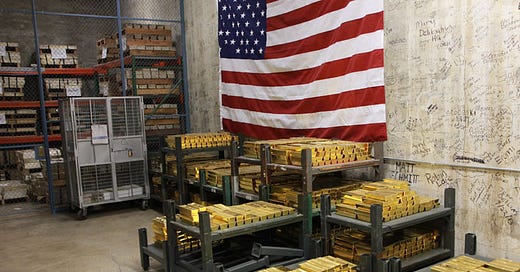The Constitutional Crisis of Fiat Currency: How America Abandoned Gold and Silver
A Plan to Circumvent the Federal Reserve: Introducing Gold and Silver-Backed U.S. Treasury Dollars
Since the founding of the United States, the Constitution explicitly mandated that only gold and silver be recognized as legal tender. Yet today, the U.S. dollar is backed by nothing more than the “full faith and credit” of the federal government—a fiat currency issued by the Federal Reserve. How did we get here, and is this system even constitutional?
1. The Constitutional Mandate for Sound Money
The U.S. Constitution is unequivocal in its requirement that states “shall make nothing but gold and silver Coin a Tender in Payment of Debts” (Article I, Section 10). Furthermore, Article I, Section 8, grants Congress the power “to coin Money” and “regulate the Value thereof,” explicitly referring to tangible, metal-based currency.
The framers, having lived through the hyperinflationary chaos of the Continental Dollar, were staunchly opposed to paper money. James Madison warned that paper money was “the instruments of tyranny,” while Thomas Jefferson insisted that gold and silver were the only constitutional forms of money.
2. Legal Tender Cases and the Rise of Fiat Currency
The first major constitutional challenge to paper money came in the Legal Tender Cases of the 1870s. Initially, in Hepburn v. Griswold (1870), the Supreme Court declared that Congress had no power to make paper money legal tender. However, just one year later, the Court reversed itself in Knox v. Lee and Parker v. Davis, establishing the precedent that Congress could issue paper money as legal tender under its implied powers.
This shift paved the way for future monetary manipulations, culminating in the establishment of the Federal Reserve in 1913.
3. The Federal Reserve and the Death of Constitutional Money
The Federal Reserve Act of 1913 fundamentally altered the American monetary system, transferring the power to issue currency from Congress to a quasi-private banking cartel. Federal Reserve Notes, backed initially by gold, became the nation’s new legal tender.
In 1933, President Franklin D. Roosevelt signed Executive Order 6102, confiscating gold from private citizens and effectively nullifying gold clauses in contracts. The Supreme Court upheld this action in the Gold Clause Cases (1935), sanctioning fiat currency despite its blatant constitutional conflicts.
4. Nixon and the Final Nail in the Coffin
In 1971, President Richard Nixon unilaterally closed the gold window, severing the last link between the U.S. dollar and gold. This action transformed the dollar into a purely fiat currency, backed by nothing but government promises.
Nixon’s action was not authorized by Congress. It was an executive overreach, driven by pressure from foreign creditors demanding gold redemption. By unilaterally abandoning the gold standard, Nixon effectively repudiated the constitutional mandate for sound money.
5. The Consequences of Fiat Currency
Since the dollar became fiat, the U.S. has experienced rampant inflation, explosive national debt, and the erosion of purchasing power. Critics argue that the Federal Reserve’s control over currency issuance violates the Constitution’s original intent and facilitates government overreach through unchecked money printing.
6. Trump’s Recent Remarks and Plan for a Gold-Backed Treasury Dollar
In May 2025, President Donald Trump publicly condemned Federal Reserve Chair Jerome Powell as a “fool” for maintaining high interest rates amid declining inflation. Trump suggested that the Fed’s monetary policy is suffocating economic recovery and proposed a return to sound money principles.
Trump’s comments have reignited calls for bypassing the Federal Reserve by issuing a gold and silver-backed U.S. Treasury Dollar. This plan would involve:
Legislative Action: Congress authorizes the U.S. Treasury to issue new currency backed by gold and silver reserves.
Gold and Silver Reserve: The Treasury would accumulate sufficient gold and silver to back the new currency, establishing a transparent valuation system.
Issuing Treasury Notes: The Treasury would print and circulate new notes, distinct from Federal Reserve Notes, redeemable in gold and silver.
Public Adoption: Encouraging use through tax incentives and public education to phase out Federal Reserve Notes.
7. Potential Global Impacts
Implementing a gold and silver-backed currency would have profound global ramifications:
Trade Dynamics: A strengthened U.S. currency could impact exports, leading to trade realignments.
Debt Holdings: Nations holding U.S. Treasuries would reassess their positions as the value of fiat dollars fluctuates.
Illicit Finance: Criminal networks reliant on fiat dollars would face stricter currency controls and greater transparency.
Conclusion: The Path Forward
The abandonment of gold and silver as legal tender represents one of the most significant constitutional crises in American history. To restore sound money, Congress would need to repeal the Federal Reserve Act, reauthorize gold and silver as legal tender, and reinstate monetary policy rooted in tangible assets rather than debt and speculation. The question remains: Is America ready to reclaim its constitutional money, or will it remain captive to the Federal Reserve’s fiat empire?









Let’s start at the very beginning… a very good place to start…
Im confused. Where will the government get the gold and silver it needs? Im for abiding by the Constitution, but trying to change all Fed Reserve Currency in circulation to gold and silver backed currency seems like an impossible task.